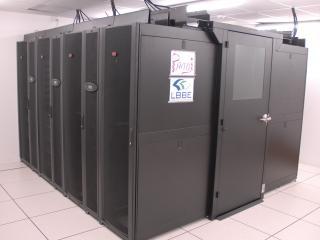Computing services
Members
Ingénieur d'études
CNRS
Tel: 04 72 44 81 42

Ingénieur d'études
CNRS
Tel: 33 04 72 43 11 68

Ingénieur d'études
CNRS
Tel: 04 72 43 35 82

Technicien
UCBL
Tel: 33 04 72 43 29 04

Ingénieur d'études
CNRS
Tel: 33 04 72 43 29 04

Ingénieure de recherche
UCBL
Tel: 33 04 72 44 85 98

Ingénieur de recherche
CNRS
Tel: 33 06 82 87 93 59

Ingénieur de recherche
CNRS
Tel: 33 04 26 23 44 70
info@listes-lbbe.univ-lyon1.fr
The "Pôle informatique" (hereafter called "PI") is constituted of 8 engineers (1T, 4IE, 3IR). Our activities are distributed among three main directions: computing and storage infrastructure management (shared resources, and invidual equipment), software and service development and data analysis in molecular biology and ecology.
Infrastructures managment
- Microcomputing: the PI is in charge of managing the laboratory's microcomputer equipment, from choosing the most appropriate solution in consultation with the future user to managing maintenance, including installation and configuration of the equipment.
- Laboratory Information System: the PI provides laboratory and community members with a number of services, including several web servers (apache), numerous database servers (relational or indexed) and several collaborative tools (Git, Redmine, Seafile...). These services are hosted on largely virtualized machines.

- Compute and storage: since 2009, the PI manages a computing cluster with almost 1200 avalaible computing cores. The cluster is linked to a 600 TB high performing distributed storage system under BeeGFS and an object mode storage based on iRods (~400 useful TB).
- Cloud and containerization: cloud-girofle (224 vcpu and 120 To), the local cloud operated by the PI since 2017, is part of the Biosphere cloud federation from the French Institute of Bioinformatics (IFB). We are starting to converge our virtualization infrastructure towards containerization technologies (docker, singularity).
- User support: the PI provides user support for all the resources and tools available to the laboratory's members. It trains and supports users in their use of shared resources through trainingsessions, information and monitoring meetings and mailing lists.
Software and methodological development
Members of the PI are involved in numerous software development projects in collaboration with the lab researchers, covering a large range of programming languages (R, Python, C++, OCaml, Javascript, SQL, shell). It goes from optimized parallel numerical codes to web services and dedicated databases (SQL or no-SQL). A peculiar effort is also performed to share the best practices of modern software development and make these software codes reproducible and available following the standards and requirements of the community.
Data analysis
Members of the PI are in the front line facing the data avalanche (and the data diversity) of this decade.
A large part of our activity is related to the quantity of data coming from sequencing technologies. The PI develops and proposes pipelines for genomic data assembly and annotation, RNA-seq and RAD-seq data analysis. More recently, computer image processing has become an important issue for future ecological studies performed in the lab in the Evolutionary Ecology.
Animation, training and scientific expertise
Our group has set up a series of dedicated workshops to improve internal skills in software engineering, distributed computing, programming and data analysis, which complements more formal teaching sessions. Members of the group are also involved in training activities in universities (UCBL1) and CNRS (Formation permanente).
In their respective fields, members of the PI actively monitor technological developments and participate in major events such as JOBIM (bioinfo), the JRES (system administration), the JDEV (development), the Aramis days (system and network administration and software development) and the 'Rencontres R' (programmation). The PI is also involved in dedicated networks and/or projects of national scope such as the LyonCalcul group, the RLyon group and the IFB-NNCR and IFB-Core projects.
We works in close cooperation with the bioinformatics platform PRABI (Pôle Rhône-Alpes de BioInformatique), notably for the management of the computing and storage infrastructure, the diffusion of our lab's software production, the organization of teaching sessions and for sharing expertise in genomic/transcriptomic data analysis.
Poster
Publications
Display of 91 to 120 publications on 170 in total
Unknown age in health disorders: A method to account for its cumulative effect and an application to feline viruses interactions.
Epidemics . 11 : 48-55
Journal article
see the publicationOptimization of multiplexed RADseq libraries using low-cost adaptors
Genetica . 143 ( 2 ) : 139-143
Journal article
see the publicationGénérer des documents avec RMarkdown
Rencontre du groupe des utilisateurs de R sur Lyon .
Conference paper
see the publicationFrom bicycle sharing system movements to users: a typology of Vélo’v cyclists in Lyon based on large-scale behavioural dataset
Journal of Transport Geography . 41 : 280-291
Journal article
see the publicationDetermining the instar of a weevil larva (Coleoptera: Curculionidae) using a parsimonious method
European Journal of Entomology . 111 ( 4 ) : 567-573
Journal article
see the publicationHost plant specialization matters in the epidemiology of Wolbachia across phytophagous wasps (Hymenoptera: Torymidae)
8. International Wolbachia Conference . : np
Poster
see the publicationStatistical handling of reproduction data for exposure-response modeling
Environmental Science and Technology . 48 : 7544-51
DOI: 10.1021/es502009r
Journal article
see the publicationEpidemiology of asexuality induced by the endosymbiotic Wolbachia across phytophagous wasp species: host plant specialization matters.
Molecular Ecology . 23 ( 9 ) : 2362-2375
DOI: 10.1111/mec.12737
Journal article
see the publicationIndexation et recodages avec R et questionr
Séminaire "R à l'usage des sciences sociales" (RUS) .
Conference paper
see the publicationApplications Web avec Shiny
Première rencontre du groupe des utilisateurs de R sur Lyon .
Conference paper
see the publicationThe rhizome of the multidrug-resistant Enterobacter aerogenes genome reveals how new "killer bugs" are created because of a sympatric lifestyle.
Molecular Biology and Evolution . 30 ( 2 ) : 369-83
Journal article
see the publicationConference Report: Deuxièmes Rencontres R
The R Journal . 5/2 : 164--165
Journal article
see the publicationGenome Sequence of Coxiella burnetii 109, a Doxycycline-Resistant Clinical Isolate
Journal of Bacteriology . 194 ( 24 ) : 6939-6939
DOI: 10.1128/JB.01856-12
Journal article
see the publicationBioNLP Shared Task - The Bacteria Track
BMC Bioinformatics . 13 : np
Journal article
see the publicationNovel measures of linkage disequilibrium that correct the bias due to population structure and relatedness
Heredity . 108 ( 3 ) : 285-291
DOI: 10.1038/hdy.2011.73
Journal article
see the publicationAn evaluation of the effects of Lactobacillus ingluviei on body weight, the intestinal microbiome and metabolism in mice
Microbial Pathogenesis . 52 ( 1 ) : 61-68
Journal article
see the publicationThe Gene Expression Analysis of Blood Reveals S100A11 and AQP9 as Potential Biomarkers of Infective Endocarditis
PLoS ONE . 7 ( 2 ) : e31490
Journal article
see the publicationHigh-quality sequence clustering guided by network topology and multiple alignment likelihood.
Bioinformatics . 28 ( 8 ) : 1078-85
Journal article
see the publicationRENABI GRISBI Infrastructure Distribuée pour la Bioinformatique
JOBIM 2011 - Journées Ouvertes Biologie Informatique Mathématique .
Conference paper
see the publicationPhEVER: a database for the global exploration of virus-host evolutionary relationships.
Nucleic Acids Research . 39 ( Database issue ) : D569-75
DOI: 10.1093/nar/gkq1013
Journal article
see the publicationOrientia tsutsugamushi Stimulates an Original Gene Expression Program in Monocytes: Relationship with Gene Expression in Patients with Scrub Typhus
PLoS Neglected Tropical Diseases . 5 ( 5 ) : e1028
Journal article
see the publicationGenetic structure and linkage disequilibrium in 4 Vitis species
Plant and Animal Genomes Conference . : np
Conference paper
see the publicationUltra-fast sequence clustering from similarity networks with SiLiX
BMC Bioinformatics . 12(116) : 1-9
Journal article
see the publicationBioNLP Shared Task 2011 - Bacteria Gene Interactions and Renaming
Proceedings of the BioNLP Shared Task 2011 ACL Workshop . 13 9781937284091 : 65-73
Conference paper
see the publicationUtilisation de grilles de calcul pour la génomique comparative
Rencontres Scientifiques France Grilles 2011 .
Conference paper
see the publicationReNaBi-GRISBI: grande infrastructure pour la bioinformatique
JOBIM 2010 - Journées Ouvertes en Biologie, Informatique et Mathématiques .
Conference paper
see the publicationRepair and Prediction (under Inconsistency) in Large Biological Networks with Answer Set Programming
Principles of Knowledge Representation and Reasoning .
Conference paper
see the publicationGenetic structure and linkage disequilibrium in 4 Vitis species
Grapevine breeding and genetics .
Poster
see the publicationGenetic structure and linkage disequilibrium in four Vitis species
10. International Conference on Grapevine Breeding and Genetics .
Conference paper
see the publication